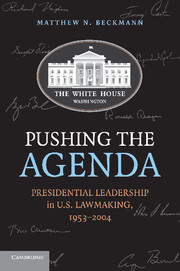Book contents
- Frontmatter
- Contents
- Dedication
- Figures
- Tables
- Acknowledgments
- 1 Introduction
- 2 A Theory of Positive Presidential Power
- 3 Case Study: Pushing President Bush's 2001 Tax Cut
- 4 Winning Key Votes, 1953–2004
- 5 Signing New Laws, 1953–2004
- 6 The Practice and Potential of Presidential Leadership
- Appendix: Archival Study Technical Details
- References
- Index
Appendix: Archival Study Technical Details
Published online by Cambridge University Press: 05 June 2012
- Frontmatter
- Contents
- Dedication
- Figures
- Tables
- Acknowledgments
- 1 Introduction
- 2 A Theory of Positive Presidential Power
- 3 Case Study: Pushing President Bush's 2001 Tax Cut
- 4 Winning Key Votes, 1953–2004
- 5 Signing New Laws, 1953–2004
- 6 The Practice and Potential of Presidential Leadership
- Appendix: Archival Study Technical Details
- References
- Index
Summary
Lyndon Johnson counseled presidents to shepherd initiatives “from cradle to grave,” adding, “There is but one way for a president to deal with Congress, and that is continuously, incessantly, and without interruption. If it is really going to work, the relationship has got to be almost incestuous” (Kearns Goodwin 1991, 226). The abstract theory that comprises this book's analytic core has put social science meat on Lyndon Johnson's intuitive bone. Specifically, I have theorized that before lobbying pivotal voters in the legislative endgame, presidents can also lobby congressional leaders in the legislative earlygame.
Given the paths by which presidents may seek influence in Congress, the follow-up question is obvious: Do they work? That is, can a presidents' lobbying affect the outcome of “key” roll-call votes, the content of the nation's laws? The answers to these questions are the subjects of Chapters 4 and 5. Here, I report the technical details of the study that yielded those data.
RESEARCH DESIGN
Part and parcel of my argument about presidential coalition building is that properly appraising it requires accounting for the entire legislative process – “from cradle to grave,” as President Johnson put it. In testing presidents' influence, therefore, the archival study described here sought to gather valid data that account for both voting and prevoting processes. I further sought data that included a myriad of contexts, spanning different presidents and Congresses, and that emphasized major domestic policy debates during the postwar period.
- Type
- Chapter
- Information
- Pushing the AgendaPresidential Leadership in US Lawmaking, 1953–2004, pp. 163 - 176Publisher: Cambridge University PressPrint publication year: 2010

